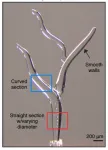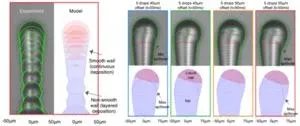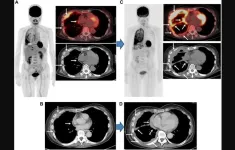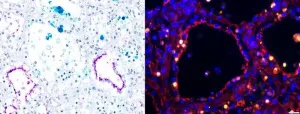(Press-News.org) Advances in 3D printing have enabled many applications across a variety of disciplines, including medicine, manufacturing, and energy. A range of different materials can be used to print both simple foundations and fine details, allowing for the creation of structures with tailored geometries.
However, creating structures with micro-scale, precise internal voids and channels still poses challenges. Scaffolds used in tissue engineering, for example, must contain a three-dimensional complex network of conduits that mimic the human vasculature. With traditional additive manufacturing, where the material is deposited layer by layer, it’s difficult to print such intricate internal features without sacrificing time, accuracy, and resources.
To address this issue, Philip LeDuc and Burak Ozdoganlar, professors in mechanical engineering at Carnegie Mellon University, are spearheading the development of the freeform 3D ice printing (3D-ICE) process. This technique uses a drop-on-demand 3D printing approach with water as a substitute for conventional printing inks. A piezoelectric inkjet nozzle ejects tiny water droplets onto a build platform maintained below the freezing point. This causes the droplets to freeze shortly after contact.
Uniquely, the process can be controlled to deposit one or more droplets before the previous droplet is frozen. As such, a water cap remains atop the printed structure, and the freezing progresses from the bottom. This enables the creation of structures with smooth walls, transitions, and branches. Features as small as human hair can be fabricated. As more droplets are deposited, an ice structure takes shape on the build platform. The diameter, height, and relative smoothness of the pillar’s geometry can be adjusted by controlling the rate of droplet deposition, and the temperatures of the printing surface, droplet, and workspace. If the build platform is shifted such that the incoming droplet hits at an angle, the freeze front will rotate accordingly, making it possible to produce branching, curved, and overhanging structures that would be challenging or impossible to print with alternative 3D printing techniques without extra support materials.
“3D ice could be used as a sacrificial material, which means we could use it to create precisely-shaped channels inside of fabricated parts,” said LeDuc. “That would be useful in a lot of areas, from creating new tissues to soft robotics.”
Since the outset of their project, LeDuc and Ozdoganlar’s research team has investigated ways to ensure that the 3D ice process is predictable and reproducible. In their recent article published in the Proceedings of National Academies (PNAS, Garg et al., 2024), they describe 2D and 3D numerical models to elucidate the physics behind 3D ice, including heat transfer, fluid dynamics, and the rapid phase change from liquid to solid during the printing process.
Their 2D models map the construction of straight pillars, including the respective effects of layered and smooth deposition. “The frequency of droplet deposition affects the height and width of the structure,” said Ozdoganlar. “If you deposit quickly, the water cap grows, producing wider structures. If you deposit slowly, then the structure becomes narrower and taller. There are also effects from the substrate temperature. For the same droplet deposition rate, a lower substrate temperature produces taller structures.”
Their 3D models map the construction of oblique structures by predicting the rotation of the freeze front. “You have all types of heat transfer, including conduction to the bottom and convection to the surrounding area,” said Ozdoganlar. “All those things are working simultaneously when you deposit each droplet. If you deposit obliquely, part of the droplet spills over on the side of the pillar before it freezes. And as you keep depositing at that angle, the freeze front slowly changes shape, and the structure grows in that direction.”
In addition to further refining their mathematical models, LeDuc and Ozdoganlar’s labs are now looking to scale up 3D-ICE and explore its efficacy across a range of applications. For instance, current strategies in tissue engineering often involve designing generalized tissues. 3D-ICE could soon make it possible to print personalized tissues that match the unique structure of each patient’s vasculature, meeting the specific needs of the patient’s body. Moreover, 3D-ICE will enable the creation of functional tissue constructs for use in understanding different diseases or developing new therapeutics.
“When I first started my lab, I would never have imagined that we would be 3D printing ice, and using it to create tissues to help people,” said LeDuc. “But our research has evolved. It has brought people like Burak and myself together, and everyone brings all sorts of different perspectives and capabilities to the table. It’s a wonderful thing to do this work together where the sum of the parts is definitely greater than the individual parts in this transdisciplinary science and engineering.”
END
Understanding the 3D ice-printing process to create micro-scale structures
2024-07-15
ELSE PRESS RELEASES FROM THIS DATE:
Children’s Hospital of Philadelphia researchers develop antioxidant strategy to address mitochondrial dysfunction caused by SARS-CoV-2 virus
2024-07-15
Philadelphia, July 15, 2024 – Building upon groundbreaking research demonstrating how the SARS-CoV-2 virus disrupts mitochondrial function in multiple organs, researchers from Children’s Hospital of Philadelphia (CHOP) demonstrated that mitochondrially-targeted antioxidants could reduce the effects of the virus while avoiding viral gene mutation resistance, a strategy that may be useful for treating other viruses. The preclinical findings were recently published in the journal Proceedings ...
How climate change is altering the Earth’s rotation
2024-07-15
Climate change is causing the ice masses in Greenland and Antarctica to melt. Water from the polar regions is flowing into the world’s oceans –and especially into the equatorial region. “This means that a shift in mass is taking place, and this is affecting the Earth’s rotation,” explains Benedikt Soja, Professor of Space Geodesy at the Department of Civil, Environmental and Geomatic Engineering at ETH Zurich.
“It’s like when a figure skater does a pirouette, first holding her arms close to her body and then stretching ...
Comparison of FDG-PET/CT and CT for treatment evaluation of patients with unresectable malignant pleural mesothelioma
2024-07-15
“FDG-PET is generally considered as a useful metabolic evaluation tool, while it is also thought to have an emerging role for assessment of systemic therapy response.”
BUFFALO, NY- July 15, 2024 – A new research paper was published in Oncotarget's Volume 15 on June 20, 2024, entitled, “Comparison of FDG-PET/CT and CT for evaluation of tumor response to nivolumab plus ipilimumab combination therapy and prognosis prediction in patients with unresectable malignant pleural mesothelioma.”
Malignant pleural mesothelioma (MPM) is an aggressive neoplasm and affected ...
New concept explains how tiny particles navigate water layers – with implications for marine conservation
2024-07-15
A new UBC study published recently in Proceedings of the National Academy of Science (PNAS) has unveiled insights into how microscopic organisms such as marine plankton move through water with different density layers.
Researchers Gwynn Elfring and Vaseem Shaik found that density layers, created by variations in temperature or salinity, influence the swimming direction and speed of tiny particles navigating a liquid.
Pushers and pullers
“There are two different types of microscopic swimmers – ...
New research shows a frictionless state can be achieved at macroscale
2024-07-15
UTICA, NY – The president of SUNY Polytechnic Institute (SUNY Poly), Dr. Winston “Wole” Soboyejo, and postdoctoral researcher, Dr. Tabiri Kwayie Asumadu, have published a revolutionary new paper titled, "Robust Macroscale Superlubricity on Carbon-Coated Metallic Surfaces." This paper explores an innovative approach to reducing friction on metallic surfaces – a significant advancement that could have major real-world impacts.
The study shows that superlubricity – a state with virtually no friction that was once believed to only be achievable at nanoscale – can now be maintained at macroscale for extended time ...
A novel and unique neural signature for depression revealed
2024-07-15
HOUSTON - (July 15, 2024) - As parents, teachers and pet owners can attest, rewards play a huge role in shaping behaviors in humans and animals. Rewards – whether as edible treats, gifts, words of appreciation or praise, fame or monetary benefits – act as positive reinforcement for the associated behavior. While this correlation between reward and future choice has been used as a well-established paradigm in neuroscience research for well over a century, not much is known about the neural process underlying it, namely how the brain encodes, ...
Academic psychiatry urged to collaborate with behavioral telehealth companies
2024-07-15
Waltham — July 15, 2024 — The strengths of academic psychiatry departments and the fast-growing private telehealth sector are complementary, according to a Perspective article published in Harvard Review of Psychiatry, part of the Lippincott portfolio from Wolters Kluwer. Justin A. Chen, MD, MPH, a psychiatrist at Weill Cornell Medicine in New York City, and colleagues reviewed literature on provision of outpatient mental health care in the United States. They concluded that academic psychiatry departments and telehealth companies could mutually benefit from strategic collaboration.
Academic medical centers struggle to ...
NASA’s Webb investigates eternal sunrises, sunsets on distant world
2024-07-15
Researchers using NASA’s James Webb Space Telescope have finally confirmed what models have previously predicted: An exoplanet has differences between its eternal morning and eternal evening atmosphere. WASP-39 b, a giant planet with a diameter 1.3 times greater than Jupiter, but similar mass to Saturn that orbits a star about 700 light-years away from Earth, is tidally locked to its parent star. This means it has a constant dayside and a constant nightside—one side of the planet is always exposed to its star, while the other is always shrouded in darkness.
Using Webb’s NIRSpec (Near-Infrared ...
Receptors make dairy cows a prime target for influenza, ISU team finds
2024-07-15
AMES, Iowa – As highly pathogenic avian influenza has spread in dairy herds across the U.S., the virus is being detected in raw milk. A new study by a broad team of researchers at Iowa State University’s College of Veterinary Medicine helps explain why.
Sialic acid, a sugar molecule found on the surface of some animal cells, acts as a receptor for influenza. Without sialic acid providing an entry point to attach, invade and infect, a flu virus is unlikely to find a potential host hospitable.
Before the recent HPAI outbreak ...
A new neural network makes decisions like a human would
2024-07-15
Humans make nearly 35,000 decisions every day, from whether it’s safe to cross the road to what to have for lunch. Every decision involves weighing the options, remembering similar past scenarios, and feeling reasonably confident about the right choice. What may seem like a snap decision actually comes from gathering evidence from the surrounding environment. And often the same person makes different decisions in the same scenarios at different times.
Neural networks do the opposite, making the same decisions each time. Now, Georgia Tech researchers in Associate Professor Dobromir Rahnev’s lab are ...





